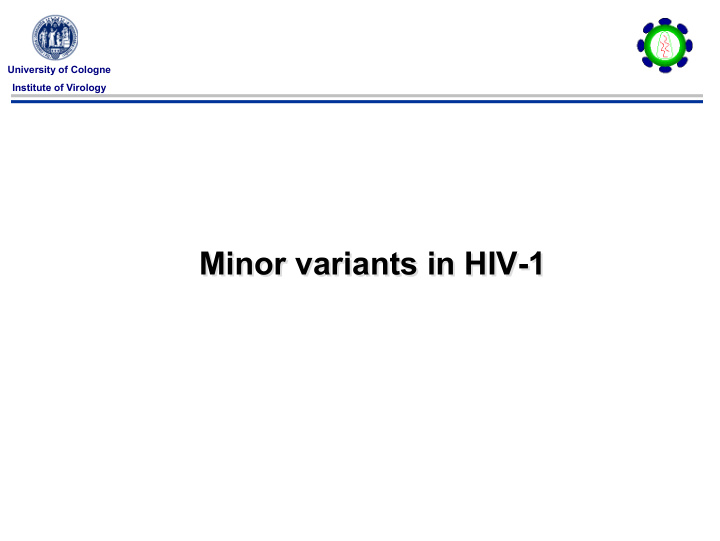



University of Cologne Institute of Virology Minor variants in HIV-1 Minor variants in HIV-1
Why? Why? University of Cologne Institute of Virology …with the method of direct sequencing only virus populations ≥ 20% can be detected. …it is important to detect mutations as soon as possible to avoid early virological failure … to know more about the evolution of viral strains under changing drug conditions (e.g treatment interruption or transmitted resistance). ….in drug classes with a low genetic barrier such as NNRTIs one mutation (e.g K103N) is enough for drug failure.
How? How? University of Cologne Institute of Virology quantification of the two different products with …with a real time assay on the LightCycler 2.0 (Roche) standard plasmids with Taqman- probes two different specific primerpairs modified method after Lecossier et al. (K103N) and Hance et al. Calculation proportion of mutant (%)= (V82A) first primerpair: equal amplification of mutant and wt K103N and K103 (amount of mutant / general amount) x 100 amplification X second primerpair: amplification of mutant and no amplification of wt X K103N K103 amp. no amp. X X
What? What? University of Cologne Institute of Virology RT PR V82A K103N
K103N K103N University of Cologne Institute of Virology characteristics: common reverse transcriptase mutation against non-nucleosidic-reverse-transcriptase inhibitors (NNRTI) for this drug class with a very low genetic barrier one mutation is sufficient to cause drug failure reported by Lecossier et al. a minority population with a K103N can get dominant under a treatment with EFV or NVP and leads to inefficacy of these drugs
K103N K103N University of Cologne Institute of Virology patients collective: 163 therapy naïve patients from the RESINA cohort 127 patients with HIV-1 subtype B 26 patients with HIV-1 non-B subtype Characteristics population based sequencing: no K103N detectable 11 patients with NRTI associated mutations (6,7%) 8 patients with a revertant at position 215 2 patients with NNRTI mutations (1,2%)
Results K103N Results K103N University of Cologne Institute of Virology Minority assay with a sensitivity of 0,2% proven shows: 163 pats 129 pats. 34 pats. K103 wt K103N 21% minority resistance
Results K103N Results K103N University of Cologne Institute of Virology Overall unexpected high prevalence of K103N in therapy- naïve patients Difference in HIV-1 subtypes? subtype B: 16% vs subtype non Bs: 40% Is this resistant minority relevant for the first line treatment? No data at the moment-further analysis could show this
V82A V82A University of Cologne Institute of Virology characteristics: protease mutation in combination with other protease mutations resistance associated for the following protease inhibitors: Indinavir (IDV), Lopinavir (LPV), Atazanavir (ATV)
V82A V82A University of Cologne Institute of Virology 8. International Congress on Drug Therapy in HIV Infection, 12-16 November 2006 Glasgow,UK Characteristics: african male newly diagnosed with HIV-1 first-line treatment: AZT, 3TC and LPV/r failed this therapy with a VL of 18724 copies/ml WHY?
V82A V82A University of Cologne Institute of Virology 3 samples available: sample 1 :before therapy; date 04.04.03 sample 2 : short after starting therapy (VL 217 copies/ml); date 01.03.04 sample 3 : after virological failure; date 16.12.04
Population based sequencing Population based sequencing University of Cologne Institute of Virology Genotypes: 1. sample: baseline genotype revertant RT T215C only 2. sample: negative result 3. sample: after failure - protease V82A and RT M41L, T215C/Y and M184V could be detected treatment: AZT, 3TC, LPV/r
Results V82A Results V82A University of Cologne Institute of Virology Population based Minority assay sequence a transmitted resistance at position V82A could sample 1 no V82A 0,2% V82A be detected and had an effect on the first therapy! sample 2 no sequence 7% V82A V82A 100% V82A sample 3
Summary Summary University of Cologne Institute of Virology overall unexpected high prevalence of K103N in therapy- naïve patients of 21% was found difference in resistant minority populations K103N in HIV-1 subtype B (16%) vs. non B subtype (40%) case report of a therapy naïve patient failing his first line regimen with AZT, 3TC and LPV: Detection of a transmitted minority population with a V82A and assumed transmitted NRTI mutations M41L, T215Y and M184V lead to virological failure
University of Cologne Institute of Virology Jürgen Rockstroh Gerd Fätkenheuer Rolf Kaiser Mark Oette Martin Däumer and colleagues Saleta Sierra Dörte Hammerschmitt Ibrahim Boussaad Thank you Jens Verheyen Elena Litau Resina study group Claudia Müller Stephanie Koch Nadine Sichtig Arne Kroidl Herbert Pfister
Recommend
More recommend